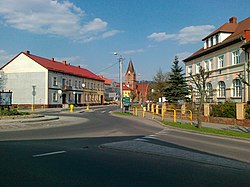소형 RNA
Small RNA작은 RNA는 길이가 200 뉴클레오티드 미만인 고분자 RNA 분자로 보통 [1]비코드화입니다.RNA 사일런싱은 종종 이러한 분자의 기능이며, 가장 흔하고 잘 연구된 예가 RNA 간섭(RNAi)이며, 여기서 내생적으로 발현된 마이크로RNA 또는 외생적으로 파생된 작은 간섭 RNA(siRNA)가 상보적인 메신저 RNA의 분해를 유도한다.piwi-interacting RNA(piRNA)와 그 아종 반복연관된 작은 간섭 RNA(rasiRNA)[2]를 포함한 다른 종류의 작은 RNA가 확인되었다.작은 RNA는 RNAi를 단독으로 유도할 수 없으며, 이 과제를 달성하기 위해서는 RNA 유도 사일런싱 복합체(RISC)라고 불리는 RNA-단백질 복합체의 핵심을 형성해야 하며, 특히 아르고나이트 단백질과 함께 형성해야 한다.[3]: 366
소형 RNA는 여러 배열 [4][5][6]플랫폼에서 MicroRNA 배열에 의해 직접 또는 게놈 배열 및 [7]분석을 통해 간접적으로 검출 또는 배열되었습니다.miRNA의 식별은 유방암과 [5]같은 인간의 질병을 발견하는 데 있어 평가되었다.말초혈액단핵세포(PBMC) miRNA 발현은 파킨슨병,[8] 다발성 경화증 [9]등 다양한 신경학적 질환의 잠재적 바이오마커로 연구되어 왔다.작은 RNA를 평가하는 것은 "라이브러리 [3]: 162 준비 전에 분자를 조각화할 필요가 없기 때문에" 특정 종류의 연구에 유용하다.
소형 RNA의 유형은 다음과 같습니다.
- 마이크로RNA(miRNA)[10]
- PiWi-Interacting RNA(piRNA)
- 소형 간섭 RNA(siRNA)
- 일반적으로 U-RNA라고도 불리는 소형 핵 RNA
- 소핵소 RNA(snoRNA)
- 소형 rDNA유래 RNA(srRNA)[11]
- tRNA유래소형 RNA(tsRNA)
- YRNA유래소형 RNA(ysRNA)[12]
식물 내
식물에서 최초로 알려진 기능은 아라비도시스의 돌연변이에서 발견되었다.특히 RNA 의존성 RNA 중합효소 및 DICER 유사 생산에 대한 기능 돌연변이의 감소와 함께.이 장애는 실제로 헤테로데라 샤흐티와 멜로이도인 자바니카에 대한 아라비도시스 내성을 강화했다.마찬가지로 Argonaute 기능이 저하된 돌연변이 - ago1-25, ago1-27, ago2-1 및 ago2-1과 결합된 돌연변이 - 는 Meloidogyne 인지불명증에 대한 내성이 더 높았다.전체적으로 이것은 식물의 작은 RNA에 [13]대한 선충 기생성의 큰 의존성을 보여준다.
레퍼런스
- ^ Storz G (May 2002). "An expanding universe of noncoding RNAs". Science. 296 (5571): 1260–3. Bibcode:2002Sci...296.1260S. doi:10.1126/science.1072249. PMID 12016301. S2CID 35295924.
- ^ Gunawardane LS, Saito K, Nishida KM, Miyoshi K, Kawamura Y, Nagami T, et al. (March 2007). "A slicer-mediated mechanism for repeat-associated siRNA 5' end formation in Drosophila". Science. 315 (5818): 1587–90. doi:10.1126/science.1140494. PMID 17322028. S2CID 11513777.
- ^ a b Meyers RA (2012). Epigenetic Regulation and Epigenomics. Wiley-Blackwell. ISBN 978-3-527-66861-8.
- ^ Lu C, Tej SS, Luo S, Haudenschild CD, Meyers BC, Green PJ (September 2005). "Elucidation of the small RNA component of the transcriptome". Science. 309 (5740): 1567–9. Bibcode:2005Sci...309.1567L. doi:10.1126/science.1114112. PMID 16141074. S2CID 1651848.
- ^ a b Wu Q, Lu Z, Li H, Lu J, Guo L, Ge Q (2011). "Next-generation sequencing of microRNAs for breast cancer detection". Journal of Biomedicine & Biotechnology. 2011: 597145. doi:10.1155/2011/597145. PMC 3118289. PMID 21716661.
- ^ Ruby JG, Jan C, Player C, Axtell MJ, Lee W, Nusbaum C, et al. (December 2006). "Large-scale sequencing reveals 21U-RNAs and additional microRNAs and endogenous siRNAs in C. elegans". Cell. 127 (6): 1193–207. doi:10.1016/j.cell.2006.10.040. PMID 17174894. S2CID 16838469.
- ^ Witten D, Tibshirani R, Gu SG, Fire A, Lui WO (May 2010). "Ultra-high throughput sequencing-based small RNA discovery and discrete statistical biomarker analysis in a collection of cervical tumours and matched controls". BMC Biology. 8 (1): 58. doi:10.1186/1741-7007-8-58. PMC 2880020. PMID 20459774.
- ^ Gui Y, Liu H, Zhang L, Lv W, Hu X (November 2015). "Altered microRNA profiles in cerebrospinal fluid exosome in Parkinson disease and Alzheimer disease". Oncotarget. 6 (35): 37043–53. doi:10.18632/oncotarget.6158. PMC 4741914. PMID 26497684.
- ^ Keller A, Leidinger P, Lange J, Borries A, Schroers H, Scheffler M, et al. (October 2009). "Multiple sclerosis: microRNA expression profiles accurately differentiate patients with relapsing-remitting disease from healthy controls". PLOS ONE. 4 (10): e7440. Bibcode:2009PLoSO...4.7440K. doi:10.1371/journal.pone.0007440. PMC 2757919. PMID 19823682.
- ^ Green, D; Dalmay, T; Chapman, T (February 2016). "Microguards and micromessengers of the genome". Heredity. 116 (2): 125–134. doi:10.1038/hdy.2015.84.
- ^ Wei H, Zhou B, Zhang F, Tu Y, Hu Y, Zhang B, Zhai Q (2013). "Profiling and identification of small rDNA-derived RNAs and their potential biological functions". PLOS ONE. 8 (2): e56842. Bibcode:2013PLoSO...856842W. doi:10.1371/journal.pone.0056842. PMC 3572043. PMID 23418607.
- ^ Billmeier, Martina; Green, Darrell; Hall, Adam E.; Turnbull, Carly; Singh, Archana; Xu, Ping; Moxon, Simon; Dalmay, Tamas (31 December 2022). "Mechanistic insights into non-coding Y RNA processing". RNA Biology. 19 (1): 468–480. doi:10.1080/15476286.2022.2057725. PMID 35354369.
- ^ Hewezi T (2020-08-25). "Epigenetic Mechanisms in Nematode–Plant Interactions". Annual Review of Phytopathology. Annual Reviews. 58 (1): 119–138. doi:10.1146/annurev-phyto-010820-012805. ISSN 0066-4286. PMID 32413274. S2CID 218658491.


